18 results
Common Core HSA-SSE.B.3a graphic organizer microsofts
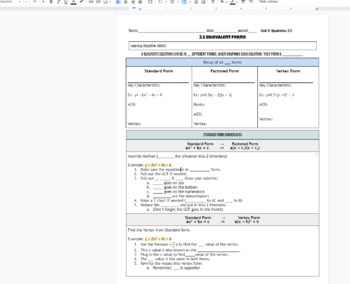
Converting between 3 forms of quadratic equations (equivalent functions) notes
Unit 3: 3.5 Converting between 3 forms of quadratic equations (equivalent functions) notes. In these scaffolded notes / graphic organizers students convert between standard, factored, and vertex form quadratic equations. The notes are broken up to show the steps on how to go from one to another. This also tells how a parabola can look like 3 different equations.Doc is editable. KEY is included in title and at the bottom of the doc. math 2 HS class. (see 3.1, 3.2, 3.3, 3.4 for previous notes!)
Subjects:
Grades:
7th - 12th, Higher Education, Adult Education
CCSS:
Also included in: Quadratic Forms & Characteristics Unit Notes & Homework

Unit Review Graphing & Characterisitics of Quadratics in all 3 forms fillable
Unit Review of 3 and 4: Graphing Quadratics and Characteristics of Quadratics in all 3 forms fillable notes study guideUnit 3 and 4 from my store, this a review that goes over that unit in a more condensed manner before their final or summative assessment.Includes:How to graph a parabola and identify the characteristics from each type fo function: standard, vertex, and factored form. The step-by-step process of solving for each key characteristic is each form! Includes description and overview o
Subjects:
Grades:
7th - 12th, Higher Education, Adult Education
CCSS:

Box Method Multiply Polynomials and Factoring graphic org visual
Box Method Multiply Polynomials and Factoring graphic org visual one page fillable. This is a support sheet / visual review showing students how to multiply binomials using the box method / square method and then factoring using the asterisk method to get the factored form. Both examples are equivalent forms. Shows converting from standard to factored and factored to standard form. Editable on google docs, may change equations if needed. Key is included linked as a PDF in the title and at the
Subjects:
Grades:
7th - 12th, Higher Education, Adult Education
CCSS:

Unit Review Quadratic Characteristics (3 forms) Fill in the blank / Cut paste
Unit Review Quadratic Characteristics (3 forms) Fill in the blank / Cut pasteStudents need to fill in the blank using a key provided (word bank) or cut and paste the definitions into each category. All 3 formsEach Equation (formula)key characterisitic of each formhow to find y intercept of eachhow to find vertex of eachhow to find x intercepts of eachwhat the negative a value isa positive a valuenarrow or widening of the graphThere is 2 versions depending on what is taught so far in the Math 2 c
Subjects:
Grades:
7th - 12th, Higher Education, Adult Education
CCSS:
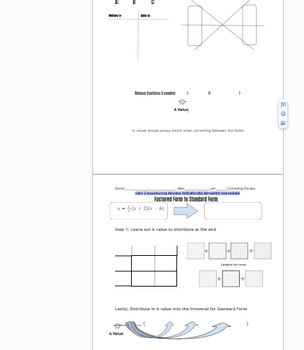
Converting between quadratic forms spaced out graphic organizer fillable
3.5 Converting between forms notes supplement graphic organizersfactored form to standard formstandard form to factored formstandard from to vertex formfactored form to vertex formvertex form to standard form(each conversion on its own page)KEY IS INCLUDED AS A LINK TO A PDF IN THE TITLE AND AT THE BOTTOM OF THE GOOGLE DOC. DOC IS EDITABLE TO YOUR LIKING IF NEED TO CHANGE EQUATIONS/DUPLICATE FOR HMK.
Subjects:
Grades:
7th - 12th, Higher Education, Adult Education
CCSS:
Also included in: Quadratic Forms & Characteristics Unit Notes & Homework
Flowchart for converting between equivalent quadratic forms (review)
Flowchart for converting between equivalent quadratic formsvertex to standardstandard to vertexfactored to vertexvertex to factored (if k=0)factored to standard standard to factoredthis is used as a review for converting between the forms on quadratic equations (all 3 forms)
Subjects:
Grades:
7th - 12th, Higher Education, Adult Education
CCSS:

Solve Quadratic Equations by Graphing and Factoring fillable notes
Unit 4: Solving Quadratics 4.1 solve by graph and factoring fillable/scaffolded notes. (See Unit 3 for previous lessons). Students have learned all about the characteristics of quadratics including factoring, now they solve and see what the solutions represent on the graph. Using the zero product property and seeing the x-intercepts. This google doc is editable. KEY is included in the title and bottom of the doc. Used in HS math 2.
Subjects:
Grades:
7th - 12th, Higher Education, Adult Education
CCSS:
Factoring Trinomials / Factor Quadratic Equations fillable notes
Unit 2, 2.3 Factoring quadratic equations, factoring trinomials using the asterisk method or snowflake method in scaffolded fillable note style. This is the last lesson before we get into quadratic functions, standard form, and the introduction to quadratics (see 3.1, 3.2, 3.3, 3.4, 3.5). Students factor standard form equations with a value of 1 and larger than 1 using the asterisk method. Google doc is editable. KEY INCLUDED in title and bottom of the doc page. Used in Math 2 HS class.
Subjects:
Grades:
7th - 12th, Higher Education, Adult Education
CCSS:
Also included in: Exponents & Polynomials Unit Bundle Fillable Notes & Homework
Unit Review of Laws of Exponents, Multiplying Polynomials & Factoring Quadratics
This is a combo of 2 previous reviews! Unit Review of 1 and 2: Laws of Exponents, Multiplying Polynomials, and Factoring Quadratic Equations in Standard form. Unit 1 and 2 are in my store as other notes, this a review that goes over that unit in a more condensed manner before their final or summative assessment.Includes:All the laws of exponents when we multiply, divide, power to a power, zero power. Also includes 3 methods of using the box method, distributive method and FOIL to multiply. Then
Subjects:
Grades:
6th - 12th, Higher Education, Adult Education
CCSS:

Factored Form of a quadratic equation scaffolded notes and graphing
Unit 3. 3.3 Factored form of quadratic functions. Students learn how the factored form of quadratic equations gives the solutions, zeroes, x-intercepts or roots of a parabola. They use different types fo factored equations to show 1 solution, 2 solutions. Google doc is editable. Graphic organizer. Fillable notes. KEY INCLUDED linked in title and on bottom of doc. Used in HS math 2 class. See 3.1, and 3.2 for previous lessons!
Subjects:
Grades:
7th - 12th, Higher Education, Adult Education
CCSS:
Also included in: Quadratic Forms & Characteristics Unit Notes & Homework
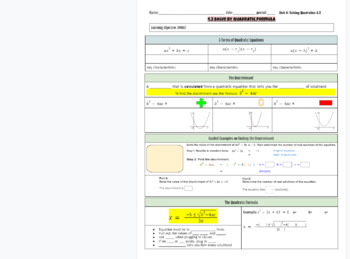
Solve quadratic equations by the quadratic formula fillable notes
Unit 4: 4.3 Solve by Quadratic Formula (See 4.1 and 4.2 for previous notes) fillable notes / graphic organizers. This is scaffolded and includes visuals of the graphs / solutions!. First students learn about finding the discriminant only by seeing the discriminant formula and telling how many solutions the answer gives. Then they use the quadratic formula to find the actual solutions along with the number of solutions. These fillable notes are on a google doc and editable. Used in HS math 2 clas
Subjects:
Grades:
7th - 12th, Higher Education, Adult Education
CCSS:

Quadratic Functions Graphic Organizer
On this graphic organizer, students will keep track of both the standard and vertex form of quadratic functions.There is a PDF key linked in the document. Teachers can use this as a way to reflect upon a quadratics unit by collecting all of the information together before a test or can use it take notes throughout a unit.
Subjects:
Grades:
9th - 12th, Higher Education
CCSS:
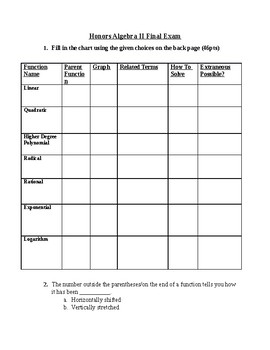
Honors Algebra 2 Final Exam
This is a concept based final exam suitable for average to honors level Algebra 2 curricula. It follows basic common core skill sets and includes probability, number sets, standard distribution, and two-way tables but not trigonometry. I use it as an assessment for the students I home-school and study guide for students in public or private school settings. The first section involves matching graphs, key terms/skills, and parent equations to the various functions introduced in Algebra 2. The voc
Subjects:
Grades:
10th - 12th
CCSS:
Also included in: Algebra 2 Bundle
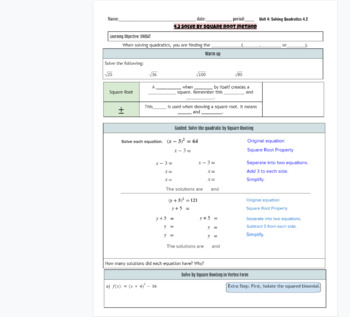
Solve quadratic equations by square rooting/ square root method fillable notes
Unit 4: Solving Quadratics, 4.2 Solve by square root method. (see 4.1 notes for the previous lesson on factor / graphing). Students use these scaffolded notes / graphic organizers to solve quadratic equations in vertex form by square rooting or the square root method. This is not completing the square. google doc is editable. KEY included in title and at the bottom of the doc. Used in HS math 2.
Subjects:
Grades:
7th - 12th, Higher Education, Adult Education
CCSS:
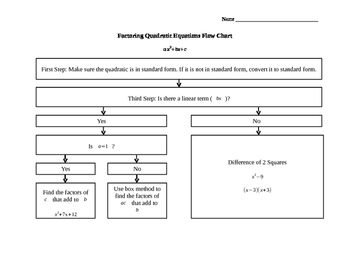
Factoring Polynomials Flow Chart (Alg I)
Kids get stuck with the process of factoring polynomials? This easy to follow flow chart shows the simple step-by-step nature of factoring polynomials.
1) GCF Factoring
2) Traditional Factoring (x^2 + bx + c)
3) a > 1 Factoring (ax^2 + bx + c)
4) Difference of Two Squares factoring
Since this resource was made for Algebra I students, the quadratic formula is not found as an option. Another flowchart (for Algebra II students) will include the quadratic formula.
Subjects:
Grades:
8th - 9th
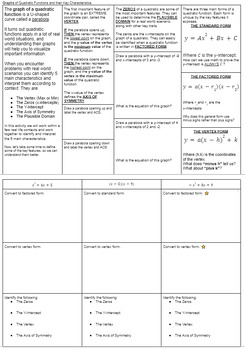
Quadratic Functions Graphic Organizer: Key Characteristics & Practice
Are you looking for an effective way to help your 9th grade students understand and master Graphs of Quadratic Functions and their Key Characteristics? Look no further than our graphic organizer with independent practice!Our graphic organizer is designed to provide a visual representation of the key concepts related to Quadratic Functions and their Graphs. It includes sections on Vertex, Axis of Symmetry, Minimum/Maximum Values, Domain, Range, and Intercepts. Each section includes a clear explan
Subjects:
Grades:
9th - 11th
CCSS:

Solving Quadratics by Factoring Foldable
This is a foldable designed to help students use factoring to solve quadratic equations. I have laid it out in three simple steps and it provides three examples where each one is a little different. The three methods of factoring shown are when the leading coefficient is 1, the leading coefficient is not 1, and a GCF. The teacher will go over each step and work the examples together as a class. Students will have the foldable to refer to and it is great for an interactive notebook. It will print
Subjects:
Grades:
9th - 11th
CCSS:
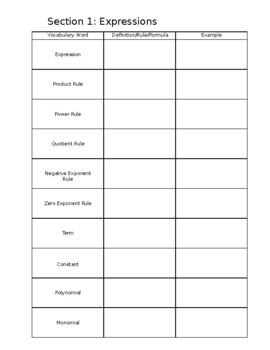
Algebra 1 EOC Vocabulary
Algebra 1 Vocabulary from each section. Completely edited. Answer key will be provided by 5/1.
Subjects:
Grades:
8th - 12th
Types:
CCSS:
Showing 1-18 of 18 results

